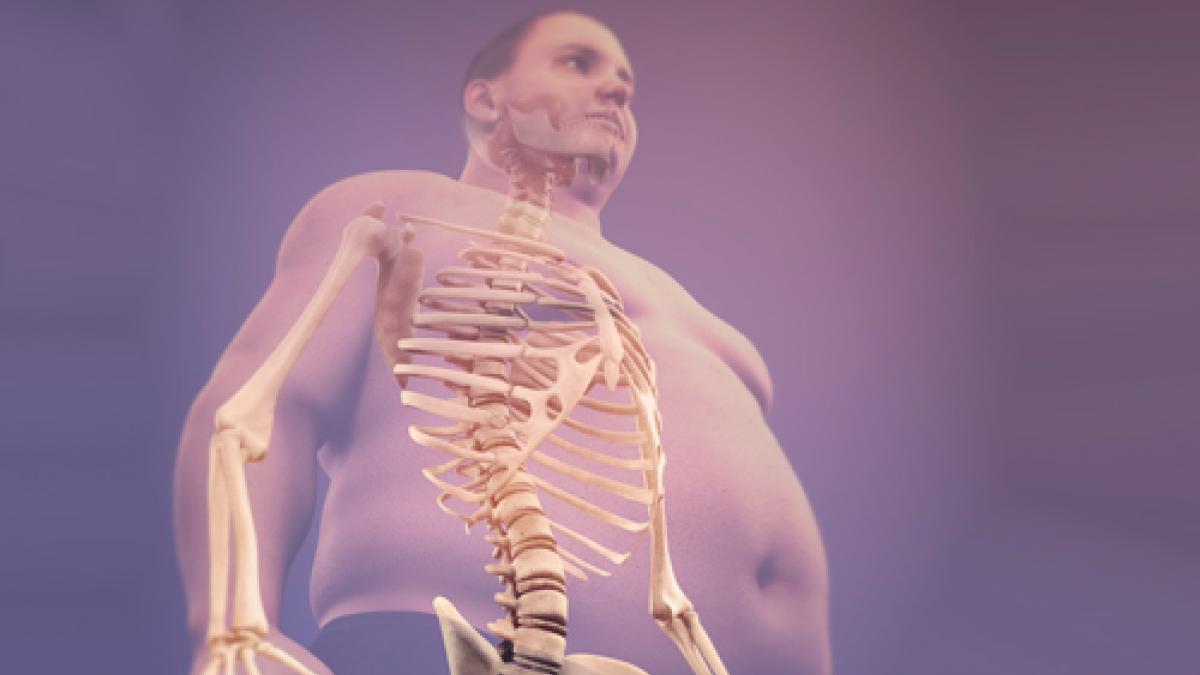Our second new column looks at the rise of obesity. Physio staff in all settings are well placed to respond. Keep up-to-date with the latest guidance and find out how you can make an impact.

Obesity is a strong predictor of adult morbidity and mortality. Any loss of weight is beneficial in reducing many of the complications of obesity.
The latest guidance on managing obesity from the National Institute for Health and Care Excellence (NICE) recommends using multi-component interventions to modify diet and physical activity behaviours as a first step.
Physical activity is important for maintaining long-term weight loss and managing co-morbidities. The guidance also suggests that effective weight management interventions often require multidisciplinary teams.
This update is based on a recent CSP Physiotherapy Works publication on obesity. For references and more information, download the full version, and others in the series .
Weight management
Physiotherapists have a role to play in preventing and managing people who are overweight and obese. Obesity leads to restrictions in movement, affecting healthy engagement in physical activity.
Exercise and movement is the keystone of the scope of physiotherapy practice.
Along with a holistic, patient-centred and problem solving approach, physiotherapists have advanced knowledge and skills in:
- anatomical, physiological, and psychosocial mechanisms of health and disease.
- assessment and diagnosis.
- behaviour change.
- biomechanics.
- exercise prescription and therapeutic exercise.
- management of long-term conditions.
Physiotherapists are therefore ideally suited to address the physical and psychological complexities of obesity.. In addition, physiotherapists provide valuable input and expertise in the multidisciplinary management of obesity, helping to optimise clinical outcomes and patient experience.
While the importance of being physically active is well recognised, in reality patients often experience difficulties in achieving this.
Many patients report their level of physical activity to be low and, among those who do exercise, the level of exercise is sometimes described as too high, with patients who are severely obese often reporting physical activity to be exhausting and painful and occasionally causing inflammation in joints.
It is important to tackle such challenges and facilitate patients to increase physical activity at the right level. This can be achieved by referral to a physiotherapist. An assessment and therapeutic treatment plan from a physiotherapist will help overcome the barriers to exercise.
A treatment plan for an obese patient may comprise:
- provision of personalised lifestyle advice, taking into account individual attitudes, beliefs, circumstances, cultural and social preferences, needs and readiness to change.
- prescription, supervision and progression of appropriate physical activity to increase muscle strength, flexibility and endurance and sustain.
- energy output to enhance and maintain weight loss under safe and controlled conditions.
- rehabilitation of associated or secondary conditions such as arthritis, back pain, and other musculoskeletal (MSK) and chronic conditions, such as heart disease.
- co-ordination of comprehensive and sustainable programmes of management in collaboration with service users, other health and social care professionals and community services.
Children and young people
Obese children, like adults, often present with a number of MSK signs and symptoms that may affect or limit their time spent in physical activity.
In addition, being obese has been shown to be detrimental to gross motor skill performance, for example in upper and lower limb coordination, balance, running speed and agility, and strength. These differences become more pronounced as children get older age, suggesting the need for early focus on motor skill development to encourage overweight and obese children to be physically active.
Physiotherapy-led exercise classes and multidisciplinary team interventions including physiotherapy input are effective in significantly improving motor skills, activity levels, and body mass index (BMI) and other anthropometry in children.
Bariatric surgery
There is mounting evidence to demonstrate that physical activity can improve weight loss and other outcomes following bariatric surgery.
It is consistently seen as being the most important predictor of long-term weight loss maintenance.
Most pre-operative patients are insufficiently active, and without support, fail to make substantial increases in their physical activity following an operation.
Even one year after surgery patients still experience social, physical and mental barriers preventing them from being physically active. These barriers can be related to side effects from surgery and lack of support to increase physical activity.
In particular, patients with balance, gait or other physical or sensory deficits should be referred to physiotherapy for this support. Patients with MSK conditions, which are especially common among bariatric patients, should also be referred.
Cost of ill-health
- It is estimated that the healthcare costs of individuals with a BMI over 35kg/m2 is twice as much that for individuals with a BMI less than 25kg/m2e.
- The cost of overweight and obesity to the NHS in the UK was £5.1 billion in 2006-07.
- The wider societal cost of overweight and obesity in England is projected to reach £27 billion this year.
Size of the problem
- In 2012, 24 per cent of adult men and 25 per cent of adult women in England were obese.
- By 2050 it has been predicted that 60 per cent of adult men, 50 per cent of adult women and 25 per cent of children in the UK will be obese.
What you need to know
Recommended evidence-based approach for the physiotherapy management of obesity:
- assess the person’s medical history.
- evaluate current physical activity level.
- provide an individualised physical activity programme.
- gradually progress a physical activity programme.
- prescribe a cardiovascular training programme.
- prescribe resistance exercises.
- prescribe moderate-intensity physical activity, for 30 minutes a day and from three to five days a week.
- calculate body mass index.
Author
Frontline Staff
Number of subscribers: 2
